|
|


ADVERTISEMENT
Buy Your own advertising
spaces!
.
Download Adobe Acrobat Reader to open [PDF] files.
Recent Visitors
Peace Hotel on the Bund
2009. 20 July
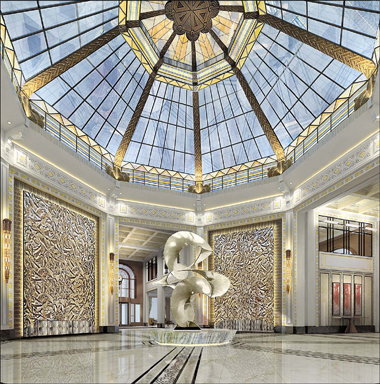 by Nancy Zhang
by Nancy Zhang
(shanghaidaily.com)
The much-loved Peace Hotel on the Bund - arguably the most famous hotel in China and at one time in Asia - has been shut for renovations for almost three years. Details of the restoration have been shrouded in mystery.
But as work enters the final phase and the 2010 opening (expected in March) approaches, the veil of secrecy has been lifted.
Spectacular pictures and fascinating information have been released of what's being billed as "an ultra-luxurious global icon for the 21st century."
They show a painstaking restoration process to reveal the long-hidden grandeur of the original Cathay Hotel, a luxurious, Art Deco masterpiece built in 1929.
The 12-story landmark, dwarfed by huge buildings around it, reopens as the rebranded Fairmont Peace Hotel.
The hotel will have 269 deluxe guestrooms and suites, eight restaurants and lounges, banquet facilities, the famed Jazz Bar - an institution since the 1930s, the legendary Peace Hall with a sprung-wooden dance floor, a magnificent restored shopping arcade, plus swimming pool, spa and other facilities.
The centerpiece of the restoration is an octagonal glass skylight and entire mezzanine level that were previously concealed.
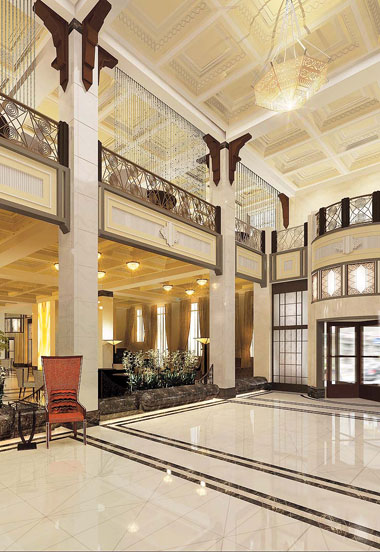 The two features were part of a luxury shopping arcade on the ground floor. Described in the 1930s as Shanghai's answer to London's Bond Street and Burlington Arcade combined, it once served Shanghai elites with designer glass, jewelry, luxury watches, fashion and undergarments.
The two features were part of a luxury shopping arcade on the ground floor. Described in the 1930s as Shanghai's answer to London's Bond Street and Burlington Arcade combined, it once served Shanghai elites with designer glass, jewelry, luxury watches, fashion and undergarments.
When the Fairmont Peace Hotel opens, the shopping arcade will once again host international luxury brands. Its doors open on all four sides of the hotel and the original floor plan is restored. It includes the Chinese character Feng meaning harvest or prosperity.
"It is our intention to recreate the grandeur and majesty of this major Asian landmark, and restore it to its rightful place as one of the world's finest hotels," says Ian Carr, principal of Hirsch Bedna Associates, the interior designers in charge of historic renovation.
The Peace Hotel's fame means the three-year restoration project is one of the most high-pressure architectural projects underway, with opening planned for guests at World Expo 2010 Shanghai.
The project involves a battalion of Chinese and foreign organizations.
Four architecture and design firms are working with two hotel management companies: the Jinjiang International Group, China's largest hotel operator, and its new management group Fairmont Hotels & Resorts.
The South Building of the former Peace Hotel is being renovated separately by the Swatch Group and will open as the Swatch Art Hotel in the spring of 2010.
People in Shanghai and the world are looking to the renovations to live up to the Peace Hotel's glorious beginnings.
It was opened in 1929 as the Cathay Hotel by British trader Victor Sassoon, the richest man in the city, and it represented an enormous investment in Shanghai's future.
It opened in an atmosphere of keen competition from other hotels - much like the situation today - and critics predicted failure, calling it too large, lavish and expensive.
They were wrong.
Filled with designer Lalique glass and state-of-the-art amenities, the Cathay Hotel forever raised the bar for hotels in the East. Rich and famous guests flooded in and it became the preeminent hotel in Shanghai and Asia.
But the hotel suffered over the years. It was damaged by bombing during the War of Resistance Against Japanese Aggression (1937-1945). During the 1950s and 1960s it was a non-commercial meeting place for state guests when luxury and capitalism were frowned up. Even when it reopened as a commercial hotel in 1978, it was never the same.
"By the time we started work on it in 2007, the city's most prized architectural asset had become a time-warped and uninspiring hotel," says Carr.
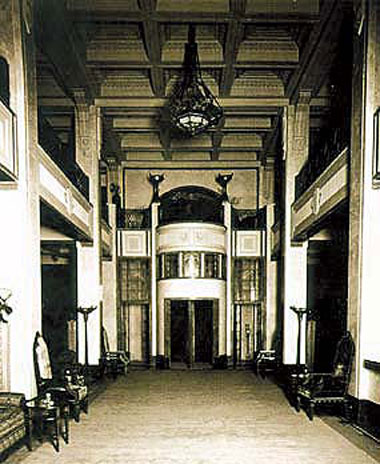 HBA have renovated even older hotels in Europe. In 1999 they restored the St Regis Grand, Rome's first deluxe hotel opened in 1894. In 2003 they restored the Hotel Grande Bretagne Athens in Greece, opened in 1874.
HBA have renovated even older hotels in Europe. In 1999 they restored the St Regis Grand, Rome's first deluxe hotel opened in 1894. In 2003 they restored the Hotel Grande Bretagne Athens in Greece, opened in 1874.
But the Peace Hotel project was uncharted waters.
The octagonal skylight is one of thousands of historical details that had to be distinguished from newer additions. Not an easy task, says the project's historic consultant Peter Hibbard.
"I came to Shanghai 20 years ago for tourism research, and fell in love with the Peace Hotel straight away," says Hibbard, who is head of the Royal Asiatic Society and author of "The Bund: Shanghai Faces East."
"I saw my main task as to right some wrongs. The official version is often flawed with myths and fantasies about what's real and what's not."
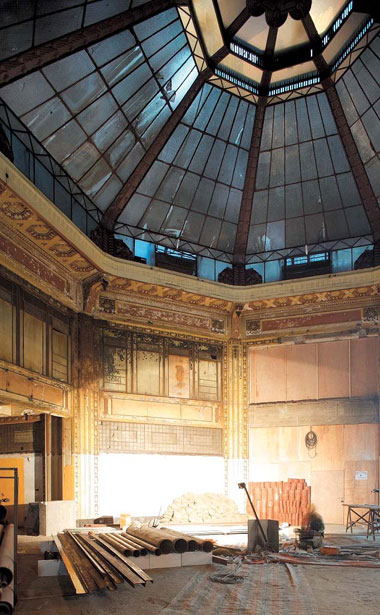 Hibbard's first task was to walk the designers through the hotel with an old Peace Hotel employee, pointing out exactly what was new and what was original. Many new imitations were added in the 1980s and 1990s.
Hibbard's first task was to walk the designers through the hotel with an old Peace Hotel employee, pointing out exactly what was new and what was original. Many new imitations were added in the 1980s and 1990s.
"Lots of marble paneling was put in during the 1980s," says Hibbard. "It looks old because Chinese craftsman are very good at reproduction. Conversely, the eighth-floor Chinese dining room looks kitsch - as if it's a reproduction of Chinese designs - but it's original. It was created for rich American tourists to experience China."
To get as much information as possible, the designers watched black-and-white movie reels shot inside the building, and even solicited the public for memorabilia and information about the original hotel. They hoped the public could also help shape its reawakening.
The understated luxury and chic of the original hotel will be reflected in the use of materials.
The color scheme will be buff and blue-gray with gray-veined marble accented with rich dark marble borders and walnut wood paneling. Refurbished copper balustrades and light fixtures will be complemented by antique bronze and polished nickel.
The 'Nine Nations Bedrooms' (guest rooms decorated to the theme of different countries) will be revived, with the Chinese, American, Indian and English suites preserved from the old hotel. The French, Italian, Spanish, Japanese and German are redesigned in keeping with their original concepts.
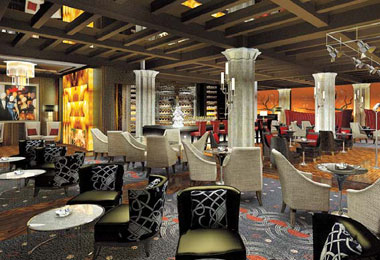 Another highlight will be the famed Peace Hall ballroom that revives memories of Shanghai cabarets and flamboyant parties.
Another highlight will be the famed Peace Hall ballroom that revives memories of Shanghai cabarets and flamboyant parties.
Fabulous parties
In the past the hotel was known for its fine dining and entertainment as much as its decor.
According to Hibbard, the 1934 party season kicked off with a schoolroom frolic. The ballroom was decked out with blackboard, maps and schoolroom props. Hotel owner Victor Sasson, dressed in a gown and wielding a birch cane, led the gaieties.
Young Americans once rented the ballroom to throw a Chinese street stall party, complete with live chickens and cockroaches.
But the days of boisterous parties, presided over by the equally boisterous owner, have long gone. A major part of the restoration is to bring back the hotel's class and commercial success.
Swiss hotels group Fairmont is known for its heritage hotels around the world, notably the Savoy in London.
Satisfying the tastes and expectations of today's discerning travelers is "not for the faint hearted," says the future general manager of the Fairmont Peace Hotel, Kamal Namaadi. He headed the opening in 2001 of the Fairmont Dubai.
As custodians of Shanghai's world-famous icon, Namaadi says they will aim to "position it as Shanghai's most luxurious hotel, and the premier social destination with unique food and beverage offerings."
"Each Fairmont property focuses on providing authentically local experiences for our guests," he says. "The guests of Fairmont Peace Hotel will experience and enjoy the flavors of the past, present and future Shanghai style."
Blending modern facilities with its legacy is key to the hotel's competitiveness as many other luxury hotels are due to open along the Bund before the Expo.
A modern low-rise extension added to the rear of the hotel will house modern facilities plus a sky-lit swimming pool and spa. The facade is designed, however, to match the old building and those along Nanjing Road. Other modern nuts and bolts will be carefully concealed.
According to Hibbard, modernization is just as essential to its revival as architectural preservation.
"When the hotel was shut down for renovations in 2007, it was the end of an era. It was the end of 100 years of continuous operation as a hotel. What's important for the future is that it becomes the most modern and luxurious it can, that it is brought back to being the best."
Expat discovers stolen artifacts
A long-time Shanghai expat, who also is an architect, has discovered stolen antiques from the Peace Hotel and helped police return them to their rightful home.
Spencer Dodington, a resident for 11 years, visited the old Peace Hotel hundreds of times "to eat, to party and to have tea. I made it part of my life because I loved it so much."
An architect who restores historic residences, Dodington was particularly sensitive to the hotel's architecture.
In May he visited an antiques "junk" shop in Jing'an District and was struck by more than 30 bronze grilles for sale. He immediately recognized them as belonging to the Peace Hotel and used to cover heaters and lights.
They were in nine different styles. Some belonged to the first floor of the Peace Hotel with international Art Deco motifs, and others belonged to the eighth floor with a faux Chinese style.
Dodington asked the store owner if the grilles came from the eighth floor, but the man replied they came from the seventh floor.
At first he tried to buy the grilles, but they were priced at 3,000 yuan (US$439) each.
Dodington then contacted the hotel management and showed them pictures of the grilles. But when they visited the store, the owner refused to sell.
"He was smart. He said, 'I am just keeping these for the Shanghai Museum,'" recalls Dodington.
Then they contacted Huangpu District police, who intervened and returned the grilles to the hotel.
"It would have been a great loss because they were so beautiful and can't be made today, the skills have been lost," says Dodington.
For his efforts, the Jinjiang Hotel Group has rewarded Dodington with a free CD of the old jazz band that was a famous attraction at the hotel, and an invitation to the opening ceremony in 2010.
"I'm looking forward to it," says Dodington. "But I hope the restoration will emphasize preservation."


